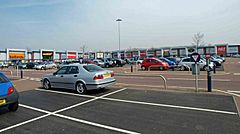Middlebrook, Greater Manchester facts for kids
Quick facts for kids Middlebrook |
|
|---|---|
 Middlebrook Retail Park |
|
| OS grid reference | SD645094 |
| Metropolitan borough |
|
| Metropolitan county | |
| Region | |
| Country | England |
| Sovereign state | United Kingdom |
| Post town | BOLTON |
| Postcode district | BL6 |
| Dialling code | 01204 |
| Police | Greater Manchester |
| Fire | Greater Manchester |
| Ambulance | North West |
| EU Parliament | North West England |
| UK Parliament |
|
Middlebrook is a lively area found between Horwich and Lostock in Bolton, Greater Manchester, England. It used to be part of Lancashire.
The name Middlebrook comes from a small watercourse called the Middle Brook. This brook starts at Red Moss. Further down, it joins other streams to become the River Croal. The River Croal flows through Bolton and eventually meets the River Irwell.
Middlebrook is a popular spot. It has big shopping areas, fun leisure places, and business offices. It's also home to the University of Bolton Stadium, where Bolton Wanderers F.C. play. You can also find Horwich Police Station here.
What's in a Name?
The name Middlebrook has a long history. It comes from old English words. "Mycel" meant "great" and "broc" meant "brook" or "stream". So, Middlebrook means "great brook."
In 1292, people wrote the name as "Mikelbrok". Over many years, it changed to what we call it today: Middlebrook.
From Farm to Fun!
Long ago, before all the shops and fun places were built, Middlebrook was a farm. It was called Sefton Fold Farm in Horwich. The farmhouse was very old, possibly built in the 1500s. It had many changes over the years.
In 1996, before the farm was taken down, experts from the University of Manchester's Archaeological Unit explored the site. They dug up an old moated area. This was like a small island surrounded by water, from the late medieval times. They also found old pottery. This pottery might have been from the late 1500s or early 1600s.
When the new buildings started, part of the farm area became a roundabout. But some old items from the farmhouse were saved. These include a special stone with the dates 1666 and 1811 on it. An old 1860s cooking range was also saved. You can see these items at the Heritage Centre in Horwich.
Middlebrook Today
The Emerson Group started building the Middlebrook complex in 1996. This huge area covers about 200 acres. The first businesses opened their doors in 1998.
Middlebrook is a big shopping and entertainment hub. It has many different shops and stores. There's a cinema with twelve screens. You can also go ten-pin bowling or grab a bite at the many cafés and restaurants. There are two hotels for visitors. The Bolton Arena Sports & Leisure Complex is also here. Horwich Police Station is located on Burnden Way within Middlebrook.
At the heart of Middlebrook is the Toughsheet Community Stadium. This stadium is the home of Bolton Wanderers F.C.. It used to be called the University of Bolton Stadium, Macron Stadium, and Reebok Stadium. The first football game was played here on September 1, 1997. It was between Bolton and Everton.
Getting Around
Middlebrook is easy to get to. It's right next to Junction 6 of the M61 motorway. The A6027 road connects the A6 to the motorway and the Middlebrook parks. It also links to the A673 road, which goes to Horwich and Bolton.
If you prefer trains, there's a regular service. Northern trains stop at Horwich Parkway railway station. This station has a Park and Ride facility. You can catch trains to Bolton, Manchester, and Preston from here. There are also several bus services. These include the 516/517 from Leigh and the 574/576/577 from Bolton.


